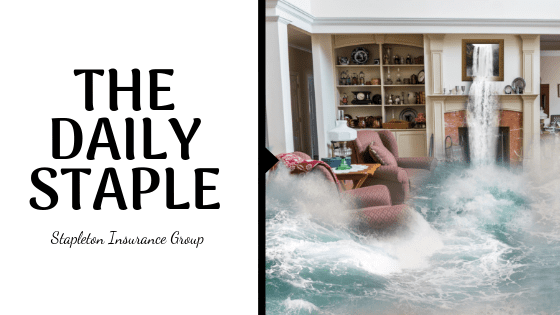Ahoy, Matey! Is all this water in your yard and basement from the abnormally large amounts of rain we have been having this year or is there a bigger problem? Maybe it’s a water back-up issue? Let’s see if we can figure out the difference, provide some prevention tips, and see how you can be covered through insurance in both cases.
Here is what you should know about Flooding:
The primary reason your basement and home can flood during a rainstorm is due to poor or blocked drainage. To help you keep water from seeping into places it’s not wanted, use the following precautionary measures you can take to protect your home and its belongings from flooding due to surface water.
Use these simple prevention tips to avoid flooding in your home:
- Make sure that the ground area within 10 feet of your home slopes away from your home’s foundation.
- Extend downspouts at least 10 feet from your home.
- Direct water flow from downspouts away from your home, being careful not to discharge the water too close to adjacent property.
- Preventive landscaping can also help reduce the chance of a mudslide or flooding.
- Clean the gutters and the drainage downspouts attached to your roof at least twice a year.
- Have your roof carefully inspected at least once a year by a capable person to check the roof thoroughly.
- If your house or commercial lot is at risk of flooding from a higher neighboring property, consider building a solid wall masonry fence on the water-vulnerable boundaries of your property.
- Be vigilant for warning signs of an impending water flood problem.
According to the Federal Emergency Management Agency (FEMA), flooding is the nation’s most common natural disaster. Twenty percent of flood claims are filed by people living in moderate- or low-risk areas. Floodwaters have the power to damage not only your home and sense of security, but also your financial future. How can you protect your most important investment? What are your flood options?
Option #1: FEMA
Many people wrongly believe that the U.S. government will take care of all of their financial needs if they suffer damage due to flooding. The truth is that federal disaster assistance is only available if the president formally declares a disaster. Even if you do get disaster assistance, it’s often a loan you have to repay with interest, in addition to any mortgage loans that you still owe on the damaged property.
Most importantly, you must consider the fact that if your home is flooded and disaster assistance isn’t offered, you’ll have to shoulder the massive damage costs alone.
The bottom line? If you’re looking for secure protection from financial loss due to flood damage, federal disaster assistance is not the answer.
Option #2: Buy Flood Insurance
When disaster strikes, flood insurance policyholder claims are paid even if a disaster is not federally declared. Flood insurance means you’ll be reimbursed for all of your covered losses. Plus, unlike federal aid, it never has to be repaid.
As long as your community participates in the National Flood Insurance Program (NFIP), you’re eligible to purchase flood insurance. Stapleton Insurance Group can assist you in determining if your community participates in the NFIP.
As a homeowner, you can insure your home up to $250,000 and its contents up to $100,000. If you’re a renter, you can cover your belongings up to $100,000. As a non-residential property owner, you can insure your building and its contents up to $500,000.
In general, a policy does not take effect until 30 days after you purchase flood insurance. So, if the weather forecast announces a flood alert for your area and you want to purchase coverage, it’s already too late. You will not be insured if you buy a policy a few days before a flood. However, if your lender requires flood insurance in connection with the making, increasing, extending or renewing of your loan, there is no waiting period.
Here is what you should know about Water Back-Up:
One of the most common homeowners insurance claims is completely preventable. It’s not fires or theft; it’s water damage. This is not damage due to flooding, heavy rainstorms or snow on the roof – rather, it’s due to simple maintenance tasks that are often ignored or go unnoticed.
Use these tips to help prevent water damage:
- Check hoses for kinks and cracks when you do laundry, and replace your washing machine hose every five years with a high-pressure hose. At a cost of less than $10, it’s an inexpensive way to ward off costly problems.
- Check for signs of leakage by inspecting the floor near your water heater and other appliances. Hire a licensed technician to periodically inspect appliances, and replace a water heater that is more than 10 years old.
- Inspect the refrigerator, dishwasher and outdoor faucets for leaks and crimps.
- Place a tub under your kitchen sink to catch leaks before they start.
- If you move your refrigerator to clean the floor, do not overextend the icemaker line. Call a licensed technician if you see signs of moisture or brittleness.
How does water damage occur? It’s simple: homeowners fail to check the connection between the water line and their washing machine or other similar appliances. Eventually, the connection fails, and water leaks into the home until someone discovers the mess. Do a quick check of all your water lines from time to time, especially in low-traffic areas of the home. If you notice anything suspicious, contact a licensed professional to come take a look immediately.
Water Back-Up Coverage can added by an endorsement to your homeowners. This coverage is for the cleanup, repair, and replacement of any personal items damaged from water or sewage in your home.
If you are still confused on whether or not you are protected contact us! We are here to help guide you through your coverage options.

